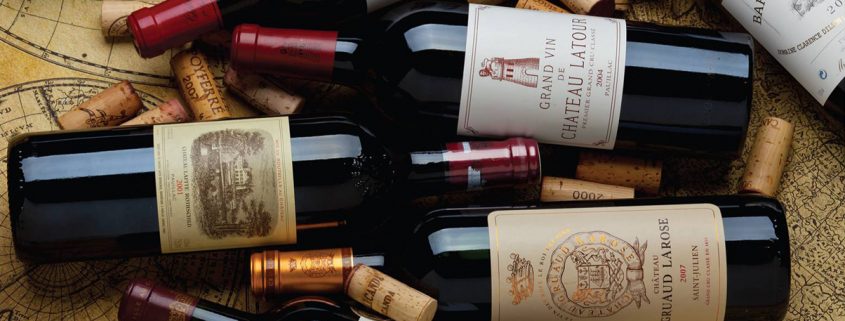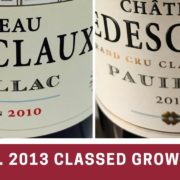En primeur
En Primeur in Bordeaux
En primeur has existed since the 18th century as a way for Bordeaux to sell unfinished wine. Negociants, or merchants, would purchase wine at a discount six months after harvest. They aged the wine themselves, sold it at full price and profited for their time and sales contacts. The chateau didn’t mind: By having fewer clients who bought more, the winery could focus on making better quality wine. With the 1855 classification of Bordeaux, came a rating system of chateaux. This was an early scoring system and caused the highest ranking houses to be in demand.
As the 20th century progressed, new technology, better transportation, and an ever-growing market meant that many wineries could sell their wine themselves. The power gradually shifted to the Chateau. Americans became interested in wine during the 1950’s and prices soared. The 1960’s saw the invention of the “mailing list”. Now, private customers received a letter with a detailed (and favorable) description of the wine and why they should buy it before the price raised. It caught on, and by the early 1970’s, demand was so high that some wine was sold sur souche, or before harvest. The Union des Grands Crus de Bordeaux was formed in 1973 and included the top 131 chateaux. It set up dinners and tastings in the wealthiest markets to promote Bordeaux and its wines. Many owners were now able to meet the clients themselves.
Descriptions were written by Negociants, and they were always favorable so the wine could be sold. There was a need for someone needed to step in with an unbiased opinion. Robert Parker rose to power for calling the excellent vintage of 1982 en primeur, and his straightforward style kept him in the spotlight for the next twenty years. By the mid-1980’s, buying en primeur had become a social fashion. Potential buyers were aware of the growing season, and good years such as 1985, 1986, 1989 and 1990 disappeared quickly. Chateau learned to rely on Parker and other writers to give their remarks and then set prices.
More recently, 2009 and 2010 were lauded as the best back-to-back vintages in a lifetime. China had just discovered her passion for Bordeaux and prices raised 40%. Traditional buyers began to be priced out. Conversely, quality suffered during 2011 and 2012. The Chateau were forced to lower the price by 30%, although many felt this wasn’t enough. Moreover, they had raised the en primeur price, causing outrage and poor sales. 2013 was worse yet, with many winemakers considering it being the most difficult vintage in thirty years. Prices were dropped a further 10% off the already depressed price, but again many felt it was too high and the interest wasn’t there.
En primeur exists because there is a large demand for a limited product. Since 1982, the price of red Bordeaux has outperformed the stock market and the price of gold. Because of this, many now buy for investment, getting the bottles at their lowest price. Many of the wines are consumed over time, making the bottles left rarer, and thus more expensive. Many are kept for years or even decades, to be sold when the price is high.
How does en primeur work? Thousands of wine writers and experts are invited to the Chateaux six months after harvest to taste unfinished wines that are still in the barrel. It can get quite crowded, especially at the top estates. They spend a week visiting the different tasting rooms and taking notes on which wines are high quality and which have under-performed. The wine is micro-oxygenated to make it ready to drink early. Samples are brought back to key players and big buyers who weren’t able to make it or were not invited. Quality is accessed and a strategy is created on which wines are the best to buy. The Chateau then sends out mailers and emails with colorful descriptions on how great the wines are, and how well they will age. They then wait, to see how Robert Parker and other influential writers will rate their wine. A favorable score can send prices up by as much as 50%.
Once scores are in, a final price is determined. The Chateau will then offer a limited amount of wine, or tranche, for sale. This is only offered to Negociants or wine brokers in Bordeaux. Those who get in early are rewarded with the best price, often buying as much as 30% under value. The Chateau offer this while the past vintage is still fresh in memory. It also gives them piece of mind knowing that some of the wine is already sold. Another reason could be to get some needed cash flow, on a product that will otherwise take two to three years to be ready.
Negociants hunt through all the Chateau and sniff out the best deals. These can be determined by taste, quality for price, or Chateau name recognition and history. Purchases are then made at discount before becoming available to the public. On top of a discounted price, the wine may increase in value. A case of 1982 Latour sold en primeur for £250, and was valued at over £9000 in 2007! This is not always the case however, with some wines losing value. This is the calculated risk that must be taken. The Chateau time their release for maximum exposure. Some announce on their own, while others might do it in groups. “Super-Tuesday” is a day where 40 chateau release their opening prices. This is done so everyone’s pricing will be in line. If they are high, they run the risk of seeming greedy, too low and they run the risk of angering your neighbours for undercutting. Uniform pricing means that everyone will sell well.
The first tranche is released to test the market. If there is sufficient enthusiasm, depending on the Chateau, several tranches can be released. Each one gains in price as the Chateaux try to get as much sold as they can. Negociants are expected to buy in poor years, which will not make much money. By doing this, they guarantee that the best (and most profitable) years are made available. Likewise, if they don’t buy a bad year, they will not be considered when a good year becomes obtainable. In the end, it is the Chateaux who make the product and maintains control over who gets it.
Moreover, Negociants must sell the wine at the price that the chateau wants or they will be punished with a small or no allocation the next year. Negociants will typically add 15-20% above their cost. They are allowed and even encouraged to make more money in good years, so these percentages can be higher. This makes up for the poorer vintages when profits are lower. Negociants then make the wine available to brokers, who tack on an additional 2% before selling it to the final client. Clients are made aware of wines through mailing lists onine and through direct mail. Once orders are in, buyers wait for two to three years until the finished wine is delivered. Everyone along the chain profits (Chateau, Negociant, and Broker) and the client still gets a deal.
There are certainly advantages to en primeur. First of all, it is tradition. Things have been done this way for decades, and the Bordelais respect that. It creates excitement in an otherwise slow time of year, when the memory of last year’s harvest is still fresh in consumers’ minds. It can provide a Chateau a “down payment” on the wine. This infusion of cash can used to invest in new equipment or replanting vineyards. It is a somewhat of a sale, so the bottom line is that this is the cheapest these wines will ever be, if you can even find them.
En Primeur works well in a rising market or when the economy is good. It also works well when the vintage has been good or excellent. Above all, and regardless of the economy or vintage, en primeur works best when the customer feels they are getting a good deal. The last five years have not been the case: New interest in China aggressively pushed the high-quality 2009 and 2010 to prices traditional customers could not afford. On the other hand, 2011, 2012, and 2013 were poor to average vintages but en primeur prices were kept too high. This has caused internal strife as to whether we should even keep the system going at all.
En primeur certainly has its disadvantages as well. Cabernet Sauvignon, Merlot, Cabernet Franc, Malbec and Petit Verdot are taken from barrels and a blend is created for en primeur participants to sample. However, this is not the final blend, so you don’t really know what you are buying. Some winemakers drastically change the blend, or even leave a grape out. A new 85% vintage law in the EU means that 15% of your wine could be from a lesser year. Although not documented, winemakers could use unwanted grapes to bump up production in an expensive year. Another potential problem is that a blend could be made to suit the taste of famous wine writers to garnish high scores. The public may receive a wine that is much different. To be sure, the wine tasted en primeur is from the oldest vines in best part of the vineyard, then made in the best barrel and micro-oxygenated. How will the finished wine in bottle compare?
Another big disadvantage is that the wine can lose value between en primeur and release. Whenever there is money to be made, there is usually risk as well, otherwise everybody would do it. En primeur has always been a risk, and while a few bottles gain immense value, most gain nominally, or stay stagnant. Some even lose value. En primeur is like playing the stock market in this way, hoping that your stock rises and that you can sell high.
Wine is considered a luxury item – something you don’t need, so in bad financial times en primeur is a flop. Customers don’t buy, whether for investment or personal consumption. Three years is also a long time to wait for something you’ve already paid for. In bad financial times, the Chateau, negociant or broker could fail, putting customers at risk for not receiving purchases. Lastly, under the current system, not much of the in demand wines make it to stores.
There are alternatives to selling fine Bordeaux. One is to not do it. One must remember that most of Bordeaux does not sell en primeur at all. Chateau Latour shocked the wine world with its decision not to participate in en primeur starting in 2012. They have decided to age the wines themselves and release them when they feel they are ready. Figures are about seven years after harvest for les Forts, and ten to twelve years for the Grand Vin. Speculators and Negociants argue that Latour is keeping the entire cellaring price themselves, and cutting them out of the deal. Chateau Latour countered, saying it is all a question of provenance, and knowing where your wine comes from. They continue on to say that their wine will be enjoyed at its peak, rather than being opened too early. Since the announcement, Cheval Blanc has also decided not to participate and Margaux and Haut-Brion have thought about leaving as well. These are all top-end Chateau of course, which have the name recognition to sell their wine at full price or above.
Should en primeur be left in place? My opinion is yes. Only 3% of Bordeaux is even sold this way. It is a complex and voluntary system that has taken shape over many years. At this point, it benefits everyone involved. Chateaux who choose to participate can sell some wine ahead of time. Negociants make smart purchases, and brokers deliver them to the customer, who still saves money. Yes, there are several parties who profit along the way, but this way the wealth is more spread out. The Chateaux decide whether to participate or not and how much wine to offer, and they are free to do it.
At its best, Bordeaux is the model for fine red wine. At its worst, it is thin and vegetal and will not age. The poor years make you appreciate the good ones that much more. This is reflected in the price, with some years costing several times as much as others. The key is that if the Chateaux are to participate, a real savings should be offered. En primeur is our last chance for any kind of savings on a product that has appreciated 1000% in the past ten years.
The current trend is that wineries are starting to step away from en primeur and this is their choice. It doesn’t mean it should be taken away from the rest. Many Chateau are still eager to do business this way – it is what they know. If, at any point, excitement is lost by either the buyer or seller, en primeur will not work. Both parties need to get something out of it.
Part of the magic of Bordeaux is the variation the seasons can bring. The Bordelais get very excited during good weather years, and en primeur is the perfect occasion to pass that enthusiasm on to both industry professionals and consumers alike. To quote Jean-Guillaume Prats of cos D’Estournel: “En primeur is selling a piece of excitement, of anticipation, of magic.”
Bibliography
Brook, Stephen. Bordeaux – People, Power and Politics. Mitchell Beazley, 2001
Robinson, Jancis. The Oxford Companion to Wine, Third Edition, Oxford University Press, 2006
Williams, David. ‘Bordeaux 2011 en primeur, no future for futures?’, World of Fine Wine magazine, Issue 36, 2012
Hanson, Anthony. ‘Bordeaux en primeur, a Fork in the River’, World of Fine Wine magazine, Issue 24, 2009
Lister, Ella. ‘Bordeaux 2013 en primeur, Selling under a Cloud’, World of Fine Wine magazine, Issue 44, 2014
Ross, Warwick and Roach, David. ‘Red Obsession, The Vintage of the Century in the Year of the Dragon’, Film, Lion Rock Films, 2013
Wineinvestment.com. Earl, Sam. ‘The Cult Wines Team: Bordeaux en primeur 2012’,03 April, 2013, Obtained July, 2014:
http://www.wineinvestment.com/wine-blog/2013/04/the-cult-wines-team-bordeaux-en-primeur-2012-schedule/



 MWT Vaccinated
MWT Vaccinated

